William Hogarth ��� a Picture of Pirate Times
Much as we would like to know what pirates really, really looked like, there is littlepictorial evidence available. No cameras existed at the time, and people withthe talent to make accurate pictures did not hang out with pirates ��� or if theydid (many sailors, after all, have proved talented artists) their work has beenlost to time.
Most artwork was paid for by the rich and powerful ��� peoplewho wanted beautiful paintings of their friends or themselves, or of lovelylandscapes. Pirates, or the poor, the downtrodden, or the often homeless orhungry people who became pirates, were not things people necessary wantedpictures of.
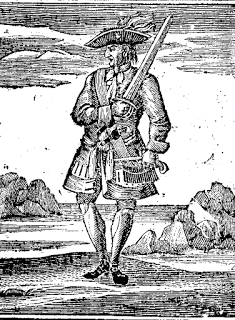 A woodcut of Jack Rackham
A woodcut of Jack Rackham
Not as detailed as an engraving But one man ��� William Hogarth, an engraver with an eye forthe humor and a love of the street life of London ��� has given us a wonderfulgroup of works that portray what the early lives of pirates might have been.
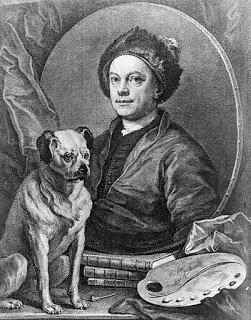 Self-portrait of Hogarth
Self-portrait of Hogarth
Using engraving
Hogarth came from the lowest rank of the middle class. Hewas apprenticed in his early teens to an engraver. This was an up-and-comingart form, which catered to the less affluent of London���s citizens.
Engraving was one of the early forms of reproducing artwork.It involved etching an image into a metal plate. When ink was rubbed across theplate, it remained in the etched lines and came off the smooth metal surface.Such a plate could be used to make hundreds of images. The technique was alsomade an image that was much more subtle and detailed than the method of carvinga picture into wood, which had come before it.
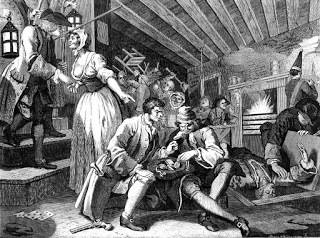 The Idle Prentice in a gaming den
The Idle Prentice in a gaming den
Hogarth worked in a shop that created what were called TradeCards. These earliest versions of business cards were commissioned by shopowners to promote their businesses. The cards showed pictures ��� the business,or some image representing it ��� a sheep for a wool merchant, cupids for someonewho sold perfume, and so on.
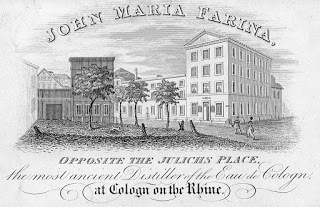
The cards quickly became popular as an end to themselves(they would later be called Trading Cards) and the business of engravingpictures for them created a new art form.Hogarth was so good at his craft that he was a self-employedengraver by the age of 23, and at 27 was to create apainting. The client initially rejected the painting, saying Hogarth was ���anengraver, and no painter��� but he successfully sued and won the money promisedin the contract.
 The South Sea bubble - colorized.
The South Sea bubble - colorized.
After this, Hogarth began creating large-sized engravingssuitable for framing. He favored satire ��� in other words, humor with a message.His first work was a comedy about the so-called ���South Sea Bubble.��� This was astock-issuing company that was supposed to explore the Pacific Ocean. Instead,it did little beside sell stock, in a Bernie Madoff-style pyramid scheme.Thousands of Londoners lost fortunes, even as others clamored to get in on theaction.
 The Enraged Musician
The Enraged Musician
After that, he created more works. Some were paintings ofthe well-to-do. But he increasingly leaned toward images of London itself, withits drunks, prostitutes, madmen and street children. One work, ���The EnragedMusician,��� is visual image of the sounds of the city. While a well-to-doviolinist tries to practice his craft, he is enveloped by street noises. Amilkmaid calls her wares, a coachman blows his horn, a knife sharpener workshis grindstone, a homeless woman with a baby sings in hopes of earning a fewcoins. These were probably the sounds Sam Bellamy heard as a boy.
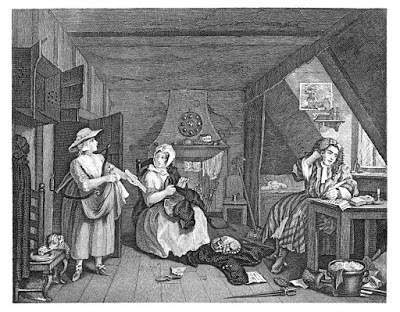 The Distressed Poet
The Distressed Poet
Many of Hogarth���s engravings illustrate the homes of thevery poor. ���The Distressed Poet��� shows a would-be writer living in a garretwith a foodless pantry and a bill collector at the door. In ���The Harlot���sProgress,��� a series of six prints, we see a young woman���s seduction intoprostitution, and her slow downfall to abject poverty and death. Of specialnote is the third image, which shows her at home in a common small apartment.The picture is so detailed that we can make out the kinds of cheap artworks theharlot has pasted to her wall ��� a picture of a famous outlaw, and some tradingcards, it looks like.
 From "The Harlot's Progress"
From "The Harlot's Progress"
The series, ���Industry and Idleness��� shows the progress oftwo young men, one who obeys the status quo and rises through London society,the other who is put off by the dull work required of him as an apprentice and fallsinto bad company while looking for fun.
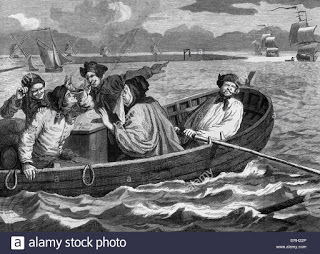 Tom Idle goes to sea
Tom Idle goes to sea
As ���Tom Idle��� falls through the ranks of society, he choosesto go to sea. This indicates the low social status of sailors, and also showsus exactly what seamen were wearing in 1747. Later we see him in the room of aprostitute (which probably hadn���t changed much in the last 30 years) and in arowdy, lower-class drinking house. Both settings suggest that ���Tom��� might havebeen engaging in a little piracy during his travels. (Watches in the hands ofthe lower classes ��� see the prostitute looking at the dangling watch ��� was usually a visual shorthand indictingtheft. A poor person couldn���t afford and wouldn���t need a watch.)
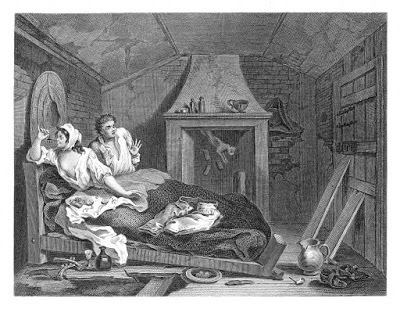 In a garret room with his whore
In a garret room with his whore
The industries apprentice also offers some interestingdetails. One image shows the morning after his marriage to his boss���s daughter.While the industrious apprentice ��� now an apprentice no more ��� hands out coinsto people who have come to beg outside his window, a servant scrapes leftoversinto the apron of a poor woman, who seems mighty pleased to have them.
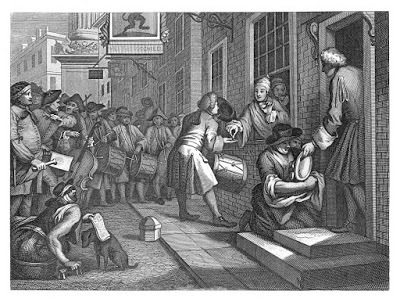 Notice the woman by the door receiving table scraps.
Notice the woman by the door receiving table scraps.
A certain level of poverty there folks. When the leavingsoff someone���s plate is a treat. Lastly we will look at the twin pictures ���Beer Street andGin Lane.��� These imaginary streets show the difference between the best side ofthe English lower classes ��� the idealized beer drinkers, and the kind ofpoverty caused by people trying to drown their sorrows in gin.
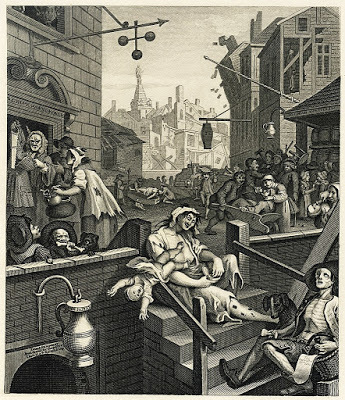 Gin Lane
Gin Lane
Gin was a new drink in England, and because it was strongand cheap it was causing social problems. On ���Gin Lane��� people pawn their toolsand household goods to buy liquor (the three balls over the door signal apawnshop.) We see people starving, fighting with dogs for bones, abandoningtheir children, and dying young, as buildings collapse form neglect.
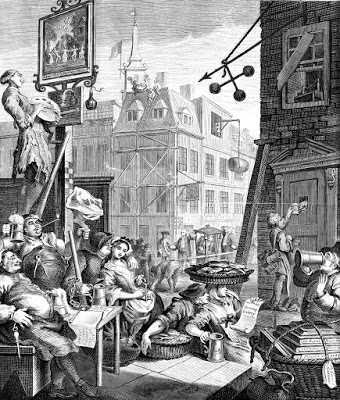 Beer Street
Beer Street
On the more idealized Beer Street, everyone seems happy andhealthy. (It is interesting to note that British beer is so nutritious thateven today, British alcoholics do not suffer the same malnutrition as Americanones.) It may be interesting to note the couple ���making out��� in the street, aswell as the ragged condition of the artist painting an advertisement for gin.
A single blog can't even begin to scratch the surface of these engravings. I strongly urge you to look at some of them yourself. In a world with Google Images it's easy to see his work. Look, and look deep - there's a three hundred year old world in there.
Most artwork was paid for by the rich and powerful ��� peoplewho wanted beautiful paintings of their friends or themselves, or of lovelylandscapes. Pirates, or the poor, the downtrodden, or the often homeless orhungry people who became pirates, were not things people necessary wantedpictures of.
 A woodcut of Jack Rackham
A woodcut of Jack RackhamNot as detailed as an engraving But one man ��� William Hogarth, an engraver with an eye forthe humor and a love of the street life of London ��� has given us a wonderfulgroup of works that portray what the early lives of pirates might have been.
 Self-portrait of Hogarth
Self-portrait of HogarthUsing engraving
Hogarth came from the lowest rank of the middle class. Hewas apprenticed in his early teens to an engraver. This was an up-and-comingart form, which catered to the less affluent of London���s citizens.
Engraving was one of the early forms of reproducing artwork.It involved etching an image into a metal plate. When ink was rubbed across theplate, it remained in the etched lines and came off the smooth metal surface.Such a plate could be used to make hundreds of images. The technique was alsomade an image that was much more subtle and detailed than the method of carvinga picture into wood, which had come before it.
 The Idle Prentice in a gaming den
The Idle Prentice in a gaming denHogarth worked in a shop that created what were called TradeCards. These earliest versions of business cards were commissioned by shopowners to promote their businesses. The cards showed pictures ��� the business,or some image representing it ��� a sheep for a wool merchant, cupids for someonewho sold perfume, and so on.

The cards quickly became popular as an end to themselves(they would later be called Trading Cards) and the business of engravingpictures for them created a new art form.Hogarth was so good at his craft that he was a self-employedengraver by the age of 23, and at 27 was to create apainting. The client initially rejected the painting, saying Hogarth was ���anengraver, and no painter��� but he successfully sued and won the money promisedin the contract.
 The South Sea bubble - colorized.
The South Sea bubble - colorized.After this, Hogarth began creating large-sized engravingssuitable for framing. He favored satire ��� in other words, humor with a message.His first work was a comedy about the so-called ���South Sea Bubble.��� This was astock-issuing company that was supposed to explore the Pacific Ocean. Instead,it did little beside sell stock, in a Bernie Madoff-style pyramid scheme.Thousands of Londoners lost fortunes, even as others clamored to get in on theaction.
 The Enraged Musician
The Enraged MusicianAfter that, he created more works. Some were paintings ofthe well-to-do. But he increasingly leaned toward images of London itself, withits drunks, prostitutes, madmen and street children. One work, ���The EnragedMusician,��� is visual image of the sounds of the city. While a well-to-doviolinist tries to practice his craft, he is enveloped by street noises. Amilkmaid calls her wares, a coachman blows his horn, a knife sharpener workshis grindstone, a homeless woman with a baby sings in hopes of earning a fewcoins. These were probably the sounds Sam Bellamy heard as a boy.
 The Distressed Poet
The Distressed PoetMany of Hogarth���s engravings illustrate the homes of thevery poor. ���The Distressed Poet��� shows a would-be writer living in a garretwith a foodless pantry and a bill collector at the door. In ���The Harlot���sProgress,��� a series of six prints, we see a young woman���s seduction intoprostitution, and her slow downfall to abject poverty and death. Of specialnote is the third image, which shows her at home in a common small apartment.The picture is so detailed that we can make out the kinds of cheap artworks theharlot has pasted to her wall ��� a picture of a famous outlaw, and some tradingcards, it looks like.
 From "The Harlot's Progress"
From "The Harlot's Progress"The series, ���Industry and Idleness��� shows the progress oftwo young men, one who obeys the status quo and rises through London society,the other who is put off by the dull work required of him as an apprentice and fallsinto bad company while looking for fun.
 Tom Idle goes to sea
Tom Idle goes to seaAs ���Tom Idle��� falls through the ranks of society, he choosesto go to sea. This indicates the low social status of sailors, and also showsus exactly what seamen were wearing in 1747. Later we see him in the room of aprostitute (which probably hadn���t changed much in the last 30 years) and in arowdy, lower-class drinking house. Both settings suggest that ���Tom��� might havebeen engaging in a little piracy during his travels. (Watches in the hands ofthe lower classes ��� see the prostitute looking at the dangling watch ��� was usually a visual shorthand indictingtheft. A poor person couldn���t afford and wouldn���t need a watch.)
 In a garret room with his whore
In a garret room with his whoreThe industries apprentice also offers some interestingdetails. One image shows the morning after his marriage to his boss���s daughter.While the industrious apprentice ��� now an apprentice no more ��� hands out coinsto people who have come to beg outside his window, a servant scrapes leftoversinto the apron of a poor woman, who seems mighty pleased to have them.
 Notice the woman by the door receiving table scraps.
Notice the woman by the door receiving table scraps. A certain level of poverty there folks. When the leavingsoff someone���s plate is a treat. Lastly we will look at the twin pictures ���Beer Street andGin Lane.��� These imaginary streets show the difference between the best side ofthe English lower classes ��� the idealized beer drinkers, and the kind ofpoverty caused by people trying to drown their sorrows in gin.
 Gin Lane
Gin LaneGin was a new drink in England, and because it was strongand cheap it was causing social problems. On ���Gin Lane��� people pawn their toolsand household goods to buy liquor (the three balls over the door signal apawnshop.) We see people starving, fighting with dogs for bones, abandoningtheir children, and dying young, as buildings collapse form neglect.
 Beer Street
Beer StreetOn the more idealized Beer Street, everyone seems happy andhealthy. (It is interesting to note that British beer is so nutritious thateven today, British alcoholics do not suffer the same malnutrition as Americanones.) It may be interesting to note the couple ���making out��� in the street, aswell as the ragged condition of the artist painting an advertisement for gin.
A single blog can't even begin to scratch the surface of these engravings. I strongly urge you to look at some of them yourself. In a world with Google Images it's easy to see his work. Look, and look deep - there's a three hundred year old world in there.
Published on January 23, 2018 20:12
No comments have been added yet.



